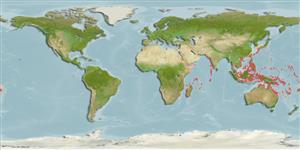Common names from other countries
Classification / Names / Names
ماع يماسا | فدارتم | Catalog of Fishes (gen., sp.) | ITIS | CoL | WoRMS
Environment: milieu / climate zone / depth range / distribution range
يسانش موب
; قمع تارييغت 0 - 7 m (Ref. 100227). Tropical
Indo-Pacific.
Length at first maturity / Size / Weight / نس
Maturity: Lm ? range ? - ? cm Max length : 2.0 cm SHL يسنج صاوخ نودب / رن سنج; (Ref. 122470)
Found in high spring tide line on rocks and driftwood (Ref. 75835). Members of the family Littorinidae are herbivores, feeding on algae which they graze with a powerful radula (Ref. 349).
Life cycle and mating behavior
غولب | لثم دیلوت | یزیر مخت | اه مخت | Fecundity | )ورال ( دازوت
Members of the order Neotaenioglossa are mostly gonochoric and broadcast spawners. Life cycle: Embryos develop into planktonic trocophore larvae and later into juvenile veligers before becoming fully grown adults.
یلصا ذخآم
عجارم | هدننك گنهامه | ناراكمه
Smith, B.D. 2003. (Ref. 3116)
NCUI زمرق تسرهف رد تيعضو (Ref. 130435)
ستياس رظن زا تيعضو (Ref. 108899)
Not Evaluated
Not Evaluated
اه ناسنا یارب رطخ
Harmless
یناسنا هدافتسا
| FishSource |
اهرازبا
رتشيب تاعالطا
Age/Size
دشر
نزو - لوط
لوط - لوط
يسانش تخير
)ورال ( دازوت
يناوارف
يتنرتنيا عبانم
Estimates based on models
Preferred temperature
(Ref.
115969): 24.9 - 29.3, mean 28.6 (based on 2097 cells).
